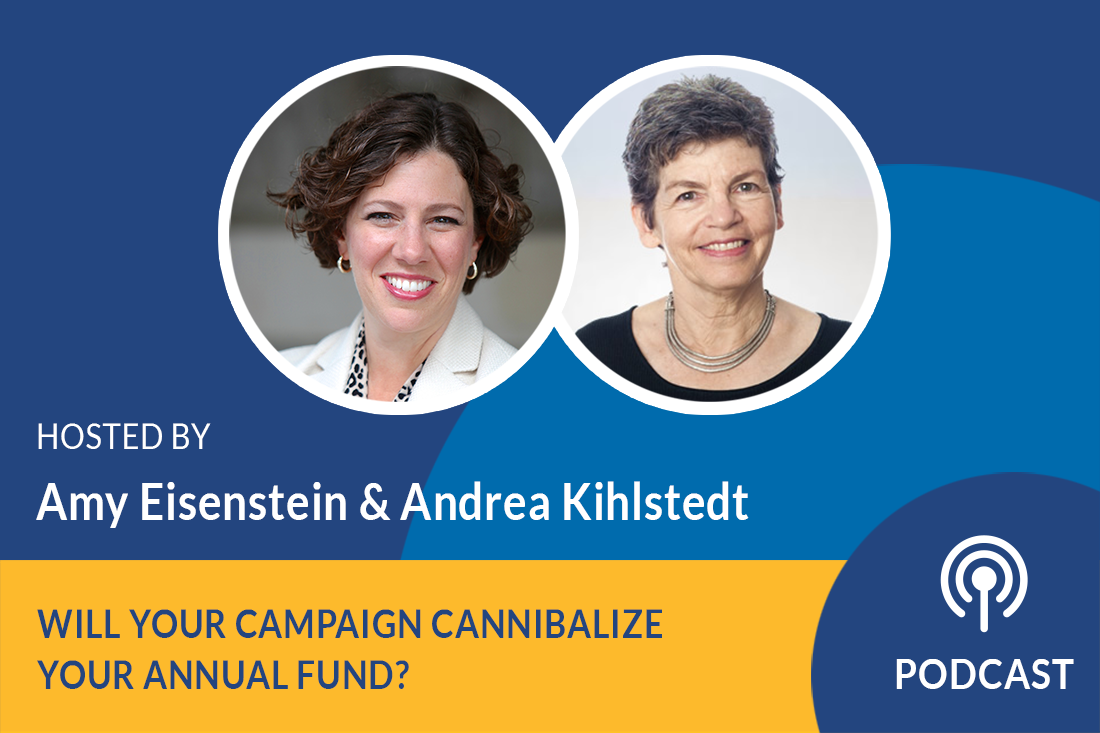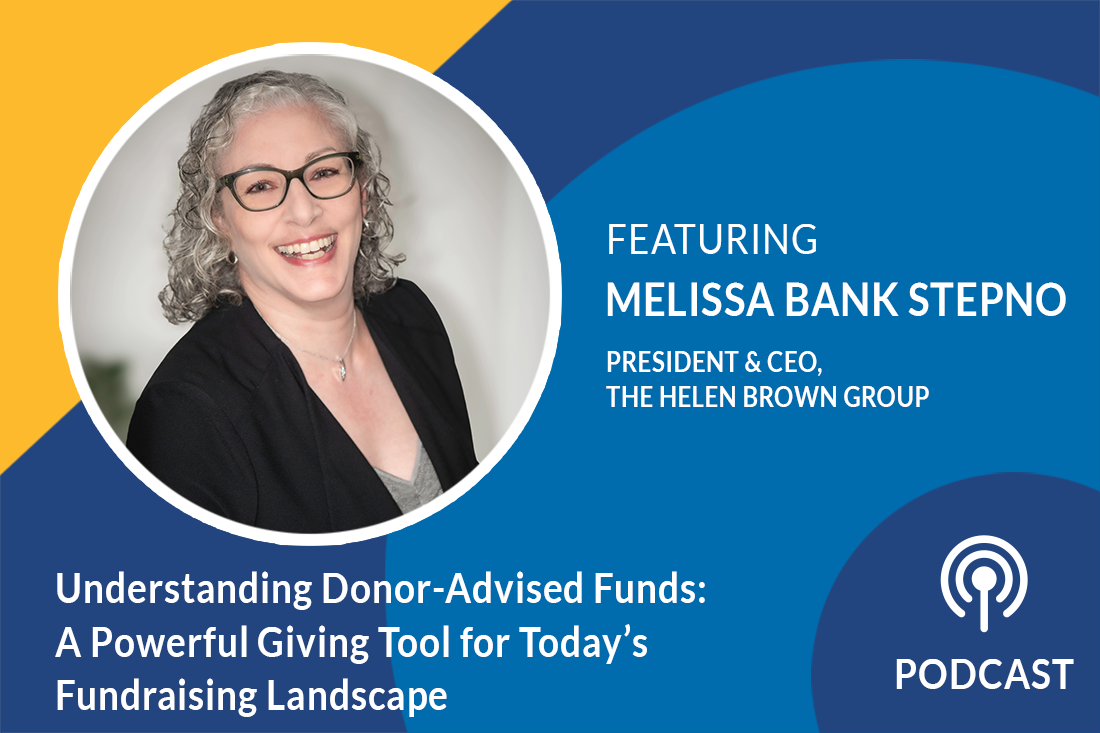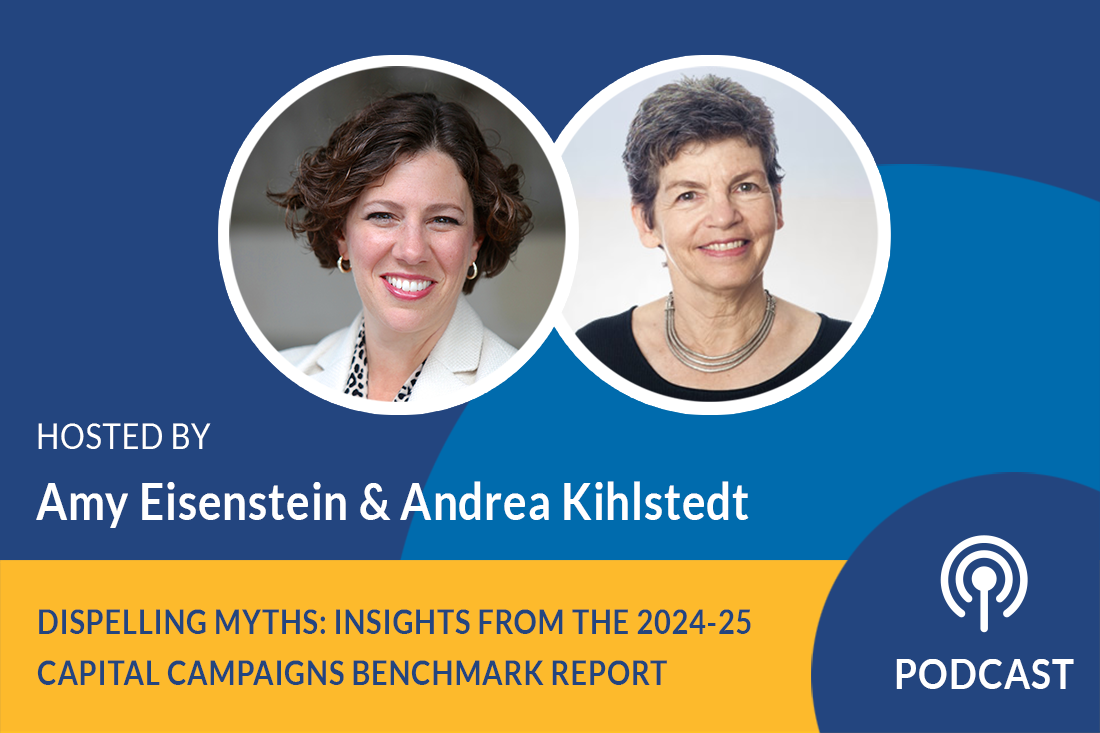Podcast: Will Your Campaign Cannibalize Your Annual Fund?

Season 3, Episode 69
Are you worried that a capital campaign might cannibalize your annual fund? If so, you’re not alone! And in this podcast, campaign experts Amy Eisenstein and Andrea Kihlstedt will tell you what to do to make sure that doesn’t happen.
Listen Now:
RESEARCH: The State of Capital Campaigns
Our research study into how capital campaigns are planned and executed found that 79% of nonprofits surveyed saw either an increase or no change to their annual fund during their campaign. See that and other interesting findings by downloading the full report.
Amy Eisenstein:
Hello, I’m Amy Eisenstein. And I am here with my colleague and co-founder of Capital Campaign Pro, Andrea Kihlstedt. And we are talking about how to make sure your campaign does not cannibalize your annual fund — one of the big worries of development directors.
You’re going to learn three things to do in your annual end of the year fundraising when you’re in campaign mode, so that your campaign does not cannibalize your annual fund.
Alright, Andrea, kick us off. What’s one thing that people should do to make sure that this does not happen?
Andrea Kihlstedt:
Yes, thanks, Amy. And it is such an important question. It’s the most frequently asked question we get actually. And here is one thing to do.
Make a Special Plan for Soliciting Your Top Donors
First of all, you have to remember that the success of your campaign is based on the top 30 gifts, maybe 20 or 30 — a roughly small number of people. And you will treat those people differently this fall. You’re not going to just keep them in the big rush of annual fundraising. You’re actually going to pull them out and you’re going to make a plan for each and every one of them, depending on what you’ve already talked to them about with regard to your annual fundraising. You may already have covered this with them. But if not, you’re going to have individual calls with each of those top 30 donors, to be sure that they know that their annual fund is over and above the campaign and that they agree on what it is they want to do.
Amy Eisenstein:
Yeah, it’s interesting. I often encourage organizations not to pull their donors from their mailing list, because what happens is that then ultimately they don’t meet with them and then they don’t solicit their biggest donors.
So Andrea’s saying, “Pull those top 30 from your annual fund.” And in this case, I agree, but be careful. Make sure that you don’t forget to solicit them in the given year. If you don’t have a plan with them, for their annual gift and their capital gift, don’t let pulling their mailing mean that you’re neglecting to solicit them. It means that you have to implement the plan, talk to them about the campaign and the annual fund at the same time. So let’s say more about that, Andrea.
Andrea Kihlstedt:
Yeah. So Amy, it makes me laugh to think that somebody wouldn’t solicit or be in touch with their largest donors.
Amy Eisenstein:
I know.
Andrea Kihlstedt:
I guess it does happen.
Amy Eisenstein:
Yes.
Andrea Kihlstedt:
But the reason to pull them out is not because you don’t want to solicit them. It’s because you want to solicit them separately and more carefully. In fact, those top 30 donors will not only make the biggest gifts to your capital campaign, but they’re likely to make the biggest gifts to your annual fundraising. They probably already do.
Amy Eisenstein:
Yes.
Andrea Kihlstedt:
So let’s say someone’s just made a half a million dollar gift to your capital campaign, and they regularly make a $25,000 gift to your annual fund. Well, you need to be talking to them about that. You can’t just send them a letter saying, “Please give to our annual fundraising.” That makes no sense. You need to call them. If that were Amy, I would call her and say:
“Amy, you have been remarkable this year with your half-million dollar gift to our campaign. And as you know, every year you give $25,000 to our annual fund. That is the life flood of our organization. And I hope this year you’re going to continue at that $25,000 or maybe even up it a little. Are you willing to consider that?”
Amy Eisenstein:
Yeah. You need to have talked about this when you solicit your capital gift, I should say, if you’ve already spoke. So there’s a couple of categories. There’s people that you’ve already solicited for your campaign, who you’re going to be reminding about your annual fund or speaking to about your annual fund. And hopefully if you solicited them well for their capital campaign gift, you already mentioned the annual fund when you did that. We call that the double mention, or the double ask.
Asking for Two Gifts at Once
And so you’re talking to them about their campaign gift, which will do one thing, and their annual fund gift, which will do another. Those are two different needs at your organization. And your most loyal and your biggest donors are going to understand those and want to help in both ways, continuing to ensure that your programs and services that you’re already delivering continue to do that. And you can’t do that without your annual fund. And you want to do this big, exciting new project, which is your capital campaign, and you’re going to be asking them for both.
So I think at the end of the year, as we approach the end of the year and fall fundraising, you need to divide your biggest potential, your biggest campaign donors into two categories. Those you’ve already asked, and so you may go back to and talk to about their capital, their annual fund gift, excuse me. And then those that you haven’t solicited yet and you need to make a very specific, careful plan for those.
Andrea Kihlstedt:
So it might make this a little easier for you to comprehend if you remember that for many large donors, they will be taking the money, they will be committing the money for their very big capital gifts, from a different place than they will be committing the money for their annual fundraising. Some people can very easily write a check for $10,000 for their annual fundraising, or can take it out of places where it’s simple for them to access that money. But when it comes to a half a million or a million dollar gift, they may do it in a more complex sort of way.
So for many donors, those different kinds of gifts come out of different pockets if you will. So it doesn’t feel like you’re just being greedy when you go and ask them. For many of them it feels like they already think about it in a slightly different way, and it will feel quite natural and appropriate for you to go back, go and talk to them about that.
Amy, let me talk just a little more about this double mention, double ask that you brought up.
Amy Eisenstein:
Yes.
Andrea Kihlstedt:
Because it’s an important concept and that is that when you’re in a capital campaign and you’re soliciting people for the campaign, you should mention that you will continue to rely on them for their annual fund gift. And when you are talking to them about their annual fund gift, you should acknowledge that you are in a campaign and that they either have made a campaign gift already, or that you’re going to be coming back to them for a campaign gift. And in some cases, you will ask for both at the same time.
You Don’t Want Your Annual Fund to Suffer
I think the important point is that rather than lumping them all together, you will actually want to acknowledge that these are two kinds of funding and they’re both critically important to your organization and you are inviting your donors to make two different kinds of gifts in a campaign period.
Amy Eisenstein:
Yes. I mean, one of the things that I like to say is that when asking for a campaign gift, whatever they decide to give should be, we hope, over and above what they normally give for the annual fund. We don’t want the annual fund to suffer. That’s critically important. So they should be thinking about their capital campaign gift as on top of the annual fund gift, not in place of it.
How Mid-Level Donors Fit into the Picture
Alright. Let’s talk about mid-level donors and the base of support. So how should we be thinking about our mid-level donors as we go into year-end fundraising?
Andrea Kihlstedt:
Yes. I think for mid-level donors, that’s really where you will be asking them for annual gift in this fall fundraising process. And you will be letting them know about the campaign, that you will be coming back to them for a campaign and this special gift. You can do that in a PS or in the body of the solicitation, but you don’t want to be surprising them later.
So that’s for this particular mid-level. These are people you are going to be asking for significant campaign gifts. These are people you might be asking for $10,000 or 25,000 or even $50,000 for the campaign. So you don’t want to ignore it when you’re asking them for their annual fund gift this fall. You want to broach that subject with them.
Amy Eisenstein:
Now we’re assuming here that folks are in the quiet phase of their campaign. They’re soliciting their largest donors. They haven’t gotten to their mid-level or base donors yet. We’re still soliciting for an annual fund gift. We’re not in the public phase, where we’re asking everybody for a campaign gift, right?
Andrea Kihlstedt:
That’s right. Once you get into the public phase and you’re going to be asking everybody for a campaign gift, then, again, you’re going to pull out the people who have already given to your campaign. And you’re going to ask everybody else for a campaign gift.
Now, the base of support, the broad base of support, this fall, unless you’re in the public phase of the campaign, you don’t really need to mention your campaign at all. You just do your standard annual fund solicitation process. Then whenever your campaign goes public and you actually are reaching out to everybody, you will go and ask them for a special gift, over and above what they’ve given for annual fundraising. Those are mostly going to be relatively smaller gifts, and you’ re going to be after participation more than getting any significant and large gifts out of that group.
Amy Eisenstein:
Yeah. When you solicit your base for support for a campaign gift, you’re going to acknowledge that they’re loyal annual fund donors and that you’re coming to them for a special one-time gift for this very exciting big project. So, as Andrea said, don’t worry about it this fall. If you’re not in the public phase of your campaign, just do your annual fund thing, make sure that’s steady and consistent.
And when it comes time for the public phase, you will solicit them for a one-time special gift, acknowledging them as already loyal annual fund donors to your organization. Alright. Any final thoughts, Andrea?
Final Thoughts
Andrea Kihlstedt:
Yeah, sure. Just in closing, I want to remind you that the success of your capital campaign depends on your top 30 donors. This is a very top heavy kind of fundraising. You have to do the rest of it. You will do the rest of it, it will raise some money. But as you move into your annual fundraising, be sure that you think very carefully about those top 30 donors to your campaign, whether you have solicited them for the campaign or not. If you do that really well, the rest of it’ll work out, and your campaign won’t cannibalize your annual fund.
Amy Eisenstein:
Excellent. I think that’s so important. Everybody’s worried about their campaign cannibalizing their annual fund, and it really doesn’t have to, it shouldn’t, and in successful campaigns, it absolutely won’t. In fact, often what we see is the annual fund grows because you’re doing more marketing, branding, outreach, you have better infrastructure and systems and you’ve honed your case. And so actually the annual fund grows during your campaign and after your campaign, if you’ve set up your campaign well.
Alright, so, if you want to talk to one of our experts or get even more information about your campaign and making sure that you’re setting it up correctly so that your annual fund is not cannibalized by your campaign, do visit our website at capitalcampaignpro.com. And you can sign up for a strategy session to talk to one of our experts to see if we would be able to help you set up your campaign for success.



Leave a Comment